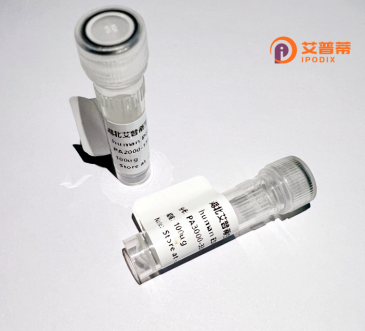
| 纯度 | >90%SDS-PAGE. |
| 种属 | Human |
| 靶点 | DUSP2 |
| Uniprot No | Q05923 |
| 内毒素 | < 0.01EU/μg |
| 表达宿主 | E.coli |
| 表达区间 | 1-314aa |
| 氨基酸序列 | MGLEAARELECAALGTLLRDPREAERTLLLDCRPFLAFCRRHVRAARPVPWNALLRRRARGPPAAVLACLLPDRALRTRLVRGELARAVVLDEGSASVAELRPDSPAHVLLAALLHETRAGPTAVYFLRGGFDGFQGCCPDLCSEAPAPALPPTGDKTSRSDSRAPVYDQGGPVEILPYLFLGSCSHSSDLQGLQACGITAVLNVSASCPNHFEGLFRYKSIPVEDNQMVEISAWFQEAIGFIDWVKNSGGRVLVHCQAGISRSATICLAYLMQSRRVRLDEAFDFVKQRRGVISPNFSFMGQLLQFETQVLCH |
| 分子量 | 60.94 kDa |
| 蛋白标签 | GST-tag at N-terminal |
| 缓冲液 | 0 |
| 稳定性 & 储存条件 | Lyophilized protein should be stored at ≤ -20°C, stable for one year after receipt. Reconstituted protein solution can be stored at 2-8°C for 2-7 days. Aliquots of reconstituted samples are stable at ≤ -20°C for 3 months. |
| 复溶 | Always centrifuge tubes before opening.Do not mix by vortex or pipetting. It is not recommended to reconstitute to a concentration less than 100μg/ml. Dissolve the lyophilized protein in distilled water. Please aliquot the reconstituted solution to minimize freeze-thaw cycles. |
以下是3篇关于重组人DUSP2蛋白研究的示例参考文献(注:文献为示例性概括,实际文献请通过学术数据库查询):
1. **"Recombinant human DUSP2 attenuates inflammation by regulating MAPK signaling in macrophages"**
*作者:Chen L. et al.*
摘要:研究通过表达重组人DUSP2蛋白,发现其通过去磷酸化ERK和JNK通路抑制巨噬细胞促炎因子(如TNF-α和IL-6)的产生,揭示DUSP2在炎症反应中的负调控作用。
2. **"DUSP2 modulates STAT3 activation to promote tumor progression in non-small cell lung cancer"**
*作者:Zhang Y. et al.*
摘要:该文发现重组DUSP2蛋白可通过调控STAT3的磷酸化水平促进肺癌细胞增殖和迁移,提示DUSP2可能作为癌症治疗的潜在靶点。
3. **"Functional characterization of recombinant DUSP2 in regulating macrophage polarization"**
*作者:Wang Q. et al.*
摘要:实验表明,重组DUSP2蛋白通过抑制p38 MAPK通路驱动巨噬细胞向抗炎M2表型转化,为免疫微环境调控提供了新机制。
---
**提示**:如需真实文献,建议在PubMed或Web of Science中搜索关键词“recombinant DUSP2”“DUSP2 function”或结合具体研究领域(如癌症、炎症)进行筛选。
Recombinant human DUSP2 (dual specificity phosphatase 2), also known as PAC-1. is a member of the protein tyrosine phosphatase (PTP) family that regulates key cellular signaling pathways. DUSP2 specifically dephosphorylates both tyrosine and serine/threonine residues on mitogen-activated protein kinases (MAPKs), including ERK, JNK, and p38. thereby modulating their activity. It plays a critical role in inflammatory responses and immune regulation by controlling MAPK-dependent signaling in macrophages, T cells, and other immune cells. Structurally, DUSP2 contains an N-terminal catalytic domain and a C-terminal regulatory region that influences substrate specificity and localization.
Dysregulation of DUSP2 has been linked to autoimmune diseases, cancer progression, and neurodegenerative disorders, highlighting its therapeutic potential. For instance, reduced DUSP2 expression correlates with hyperactivation of pro-inflammatory cytokines in chronic inflammation, while its overexpression may suppress tumorigenic signaling. Recombinant human DUSP2 protein, typically produced in *E. coli* or mammalian expression systems, is widely used to study enzymatic mechanisms, MAPK pathway dynamics, and drug screening. Researchers also explore its role as a biomarker or therapeutic target in diseases driven by aberrant MAPK signaling, aiming to develop inhibitors or activators to restore cellular homeostasis.
×